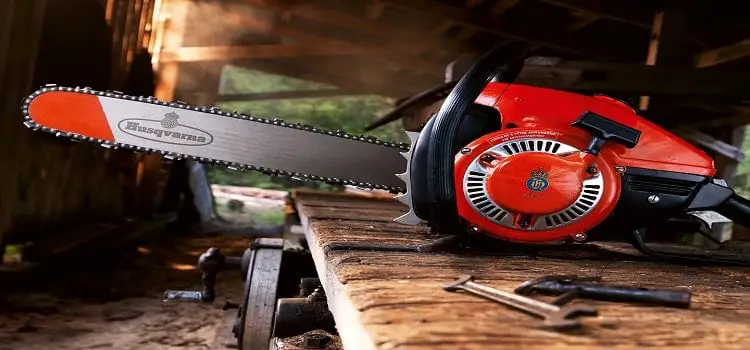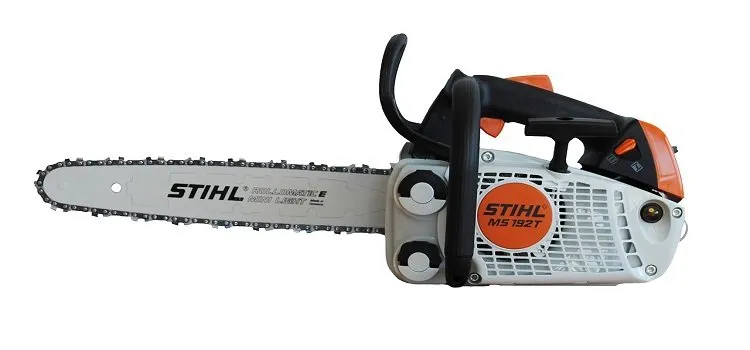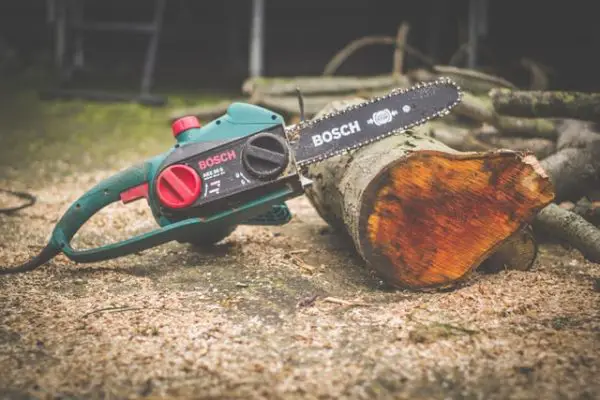Do you know why you should store a chainsaw properly? One of the apparent reasons is your chainsaw’s safety as you are not using it for a long time. A chainsaw that isn’t appropriately stored may not work after a specific time.
As we all know, a chainsaw is quite expensive, and buying a new one every 2/3 years looks irritating. Now, to keep your chainsaw active for years, you must learn how to store a chainsaw.
For a different time frame, there are several procedures for storing a chainsaw. For example, if you want to store a chainsaw for 5 years, the 6 monthly process won’t work out for you. Also, you may need to oil your chainsaw’s metallic portions, empty the tank, and run it dry as well.

There is so much to know to store your chainsaw without any damage for years. That’s why we have a proper guideline with some essential hacks that you need for storing your chainsaw correctly.
What Happens if You anyhow Store a Chainsaw?
Suppose you don’t want to follow a procedure and just anyhow store your chainsaw. What’ll happen?
Well, if you store the chainsaw anyway without following a proper guideline, then in return, instead of an active chainsaw, you’ll find-
- A chainsaw that has damaged rubber in it
- Rock-solid anti-vibration mounts
- Rust on the metallic portion of your chainsaw
- The worst situation is the chainsaw won’t start
If you want to avoid all these issues, you have to follow a specific guideline, don’t you?
Why you shouldn’t store the saw without following the proper storing process?

For electric and battery-operated chainsaw users, storing it is an easy task, but for gasoline operated chainsaws, it’s a bit complicated.
However, if you are using a gas chainsaw, things will be quite problematic, and for storing the chainsaw with fuel/gas, you might face a few challenges.
The leading problem with the gas inside is that it’ll stain up the chainsaw’s tank and carburetor. It’ll also build a sticky atmosphere inside the carburetor of the chainsaw.
Because of the engine’s fuel, the anti-vibration mount’s raw material becomes harder, like stone with time.
The chainsaw rubber also tolerates the roughness of ethanol and other supplements, which damages the quality relatively.
If you don’t store the chainsaw properly, then some of the parts will become rusty (especially the metallic portion of the chainsaw).
In case you used the chainsaw before storing it, the possibilities are it has fuel in it. Now, what to do if you have fuel in the tank? In the next section, you’ll find the solution to it as well.
Before Storing the Chainsaw: How to empty the tank and run dry
In case you want to store the chainsaw for year/s, you should follow this procedure before storing, and the process is:
At first, you must drain all the fuels that are stored in the chainsaw’s fuel tank. Once the tank became empty, but there’s still some oil available that isn’t drainable, you have to set it in a lower position and run the chainsaw. Don’t use it for cutting wood; just run it to turn off once the fuel ends.
After emptying the fuel tank, remove the spark plug from the machine and loosen the screw of the chainsaw. After removing the spark oil, you’ll find the cylinder. If you want to store it for a long time, you can use fogging oil in the cylinder.
During this procedure, we highly recommend you drain fuel from the engine and make it empty.
For power increment, most of the chainsaw users open the sparks arrestor screen. However, we recommend you put it back. It’ll keep the chainsaw’s engine safe from bugs and insects.
In case you want to store it for a few months (up to six months), then we recommend you store some gasoline in the chainsaw’s tank and run it for at least five minutes every month.
If you do this once a month, your engine will be active as the gasoline will spread around all the essential parts of the engine.
Why and How to apply Oil to a Chainsaw?

Oil works as a durable shield for metals. That’s why you should use oil on the crucial parts of the chainsaw for better results.
We also recommend you use oil on rubber as it decreases the damaging percentage. However, the rubber won’t last for a long time; oil will only reduce the damage rate.
The metallic portion of your chainsaw gets corrosion and rust once water and the sun get in touch. For surviving in this tough weather from rust and corrosion, you should oil the chainsaw.
Well, you don’t have to buy some oil or use it from your intake gallon; instead, the excess oil you got from the fuel tank of the chainsaw, use that!
But what if you do not have access to enough oil? In that case, just rub some oil on a cover and now wipe with an old used cloth in the metallic section of your saw to protect against rust.
As oil is the only savior when it comes to the rusty chainsaw, that’s why we recommend you use any sort of oil (such as virgin oil or olive oil). If you mix olive oil with cod liver oil, you can use it in metallic parts, and it’ll work1
Even if you are out of virgin, olive, or COD liver oil, just use any oily item because it will create a coating that fights against rust.
Is Storing a Chainsaw a Difficult Job?
In the beginning, it seems to be a challenging job. However, a proper guide like this will help your cause. What you must do is, understand the timeframe of storing the chainsaw.
Once you decided the timeframe, now it is time to follow the step-by-step guideline. So, it is not that tough as it looks or as you are assuming!
How to Store a Chainsaw Properly?
We have divided it into three types according to the timeframe. Which are-
- Short time (up to 6 months)
- Medium time (up to 1 year/s)
- Long time (up to 10+ years)
No matter how long you are storing, make sure you get a compression test done! If compression testing isn’t possible, then double-check the pistons of the chainsaw.
Why testing? It is because storing a damaged one is stupidity instead of repairing it and getting it stored!
Storing a Chainsaw for a Short Time (up to 6 months)
1st step: Drain out all the fuels of your chainsaw.
2nd step: Once draining is done, now start the chainsaw and run it until it automatically turns down.
3rd step: choke it for the last drop of the fuel, which will make your chainsaw’s engine tank 100% empty.
4th step: Now, apply some oil to the cylinder to keep it safe from gumming up. After using some oil, just pull the starting string a few times.
Now, your chainsaw is ready for storing for up to six months.
Storing a Chainsaw for a Medium Timeframe (up to 2 years)
Most people do this from one winter to another. However, if you want to get it stored for a year or more, then here is what you need.
The process for short and medium-term storage is almost the same. The only difference is that in short term storage, you shouldn’t keep gas/fuel inside the tank. But, you have the option to keep the gas/fuel if you want to store it for a year or two.
This time you need to invest a couple of bucks to save the gas inside your chainsaw engine’s tank for up to two years. For this, you must get a Sta-Bil, which keeps the gas and fuel fresh for around two years.

If you don’t want to invest, then you may follow the next method!
Storing a Chainsaw for an Extended Timeframe (up to 10 years)
If you want to see your chainsaw in mint condition even after one for two decades of storing, then there are some tips you need to follow.
You may also need to get some accessories like fogging oil and a complete carb kit. So, let’s get started:
Step 1: Get some warm-up done.
Start the saw and keep running it until it gets warmer than it should be.
Step 2: Use fogging oil

As we said, as you got the fogging oil, remove the air filter, and use the fogging oil by spraying it inside. Keep spraying for around 30 seconds. After that, explode the spray can to stop the engine.
Step 3: Drain all fuel and clean it.
Drain all the fuel from the engine’s fuel tank and clean it properly to make it 100% fuel-less. After that, take apart the carb and clean it properly.
Step 4: Use the complete kit and apply oil.

We hope you have already got the complete kit for the carb. In this complete kit, you’ll get everything like the primer, air filter, gasket, fuel filter, I.D, fuel lines, and spark plug.
So, replace all these that you’ll get in the complete kit. Now, it’s time for oiling. Apply oil in the gasket and all other metallics of the chainsaw.
Now, your chainsaw is ready to get stored for decades!
How to Maintain a Chainsaw when it is Stored
Here are some quick tips that will keep your chainsaw safe and sound when it’s stored:
- Do not let your chainsaw experience direct water or daylight. Also, avoid ultraviolet as it is dangerous towards your saw. Make sure you cover them properly. If possible, get a chainsaw case; your chainsaw will remain safe inside the case.
- Don’t store your chainsaw on the concrete floor as these floors are soggy and can easily damage the chainsaw. Try to hang it on the wall of a cupboard or keep it on a wooden stage before placing it on the ground.
- Avoid moisture and dust as much as possible from your chainsaw.
- To boost the chainsaw’s life, apply a couple of drops of formulated oil for the chainsaw into the crankshaft and the chainsaw tank.
Conclusion
Whether you are using a chainsaw for home or professional purposes, you should maintain it to get the optimum service out of it.
Unfortunately, most of the chainsaw users don’t store the chainsaw properly, and after a few months/years, when it doesn’t work, they start whining about it.
We hope now you have understood how to store a chainsaw and how essential it is. Haven’t you?
In the end, store your chainsaw correctly so that it’ll work even after years and decades like new, and don’t forget to do a compression test before storing!


